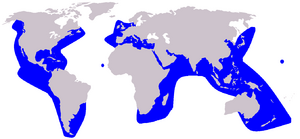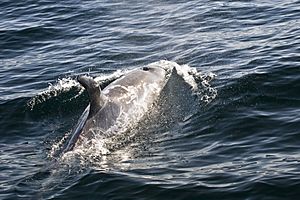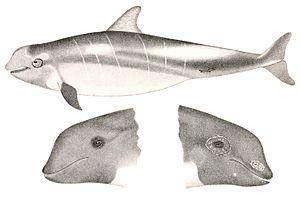Risso's dolphin facts for kids
Quick facts for kids Risso's dolphin |
|
|---|---|
 |
|
 |
|
| Size compared to an average human | |
| Conservation status | |
| Scientific classification | |
 |
|
| Distribution of Risso's dolphin |
The Risso's dolphin (scientific name: Grampus griseus) is a special type of dolphin. It's the only species in its group, called Grampus. In some places, like among Taiwanese fishermen, it's also known as the Monk dolphin.
This dolphin is related to other interesting ocean animals. These include pilot whales, pygmy killer whales, melon-headed whales, and false killer whales.
Contents
What Does a Risso's Dolphin Look Like?
Risso's dolphins have a unique look. Their front body is quite large, and they have a tall dorsal fin (the fin on their back). Their body then gets narrower towards their tail. They have a round head with a special crease on the front.
How Their Colors Change
When Risso's dolphins are babies, they are grey to brown on top. Their belly is a creamy white color. They also have a white, anchor-shaped mark near their front fins and around their mouth.
As they grow older, the darker parts of their body become almost black. Later, these areas lighten up again, except for their dorsal fin, which stays dark.
Scars and Teeth
One very noticeable thing about older Risso's dolphins is their scars. They get many linear scars, mostly from playing and interacting with other dolphins. While many dolphins have scars, Risso's dolphins often have a lot of them. Very old dolphins can even look mostly white because of all their scars!
Most Risso's dolphins have two to seven pairs of teeth. All of these teeth are found only in their lower jaw.
Size and Weight
Risso's dolphins are usually about 10 feet (3.0 m) long. Some can grow even bigger, up to 13.12 feet (4.00 m). Like many dolphins, males are usually a little larger than females.
These dolphins can weigh between 300–500 kilograms (660–1,100 lb). This makes them the largest species that is called a "dolphin."
Where Do Risso's Dolphins Live?

Risso's dolphins live all over the world in warm and mild waters. You can find them in the tropical parts of the Indian, Pacific, and Atlantic Oceans. They also live in the Persian Gulf, the Mediterranean, and the Red Sea. However, they are not found in the Black Sea.
They can be found as far north as the Gulf of Alaska and southern Greenland. They also live as far south as Tierra del Fuego.
Their Favorite Home
These dolphins prefer to live just off the edge of the continental shelf. This is where the ocean floor drops steeply. They like water that is between 400–1,000 m (1,300–3,300 ft) deep. The water temperature should be at least 10 °C (50 °F), but they prefer it to be between 15–20 °C (59–68 °F).
How Many Risso's Dolphins Are There?
Scientists have estimated that there are more than 60,000 Risso's dolphins living around the continental shelf of the United States. In the Pacific Ocean, a count showed about 175,000 dolphins in the eastern tropical waters. Another 85,000 were found in the west. There isn't a total number for all Risso's dolphins around the world yet.
Risso's Dolphin Behavior
Social Life
Risso's dolphins are interesting because they don't need sharp teeth to eat their prey, which are mostly squid. This means their teeth have changed over time to be used for other things. They often use their teeth as a way to show off during mating or when they have disagreements with other dolphins. This is how they get many of their unique scars!
Reproduction and Life Cycle
A female Risso's dolphin carries her baby for about 13 to 14 months. They usually have a new calf every 2.4 years. In the eastern Pacific, most babies are born in the winter. In the western Pacific, they are born in the summer and fall.
Female dolphins become ready to have babies when they are 8 to 10 years old. Males are ready when they are 10 to 12 years old. The oldest Risso's dolphin found lived to be almost 40 years old.
See also
 In Spanish: Calderón gris para niños
In Spanish: Calderón gris para niños



